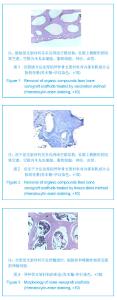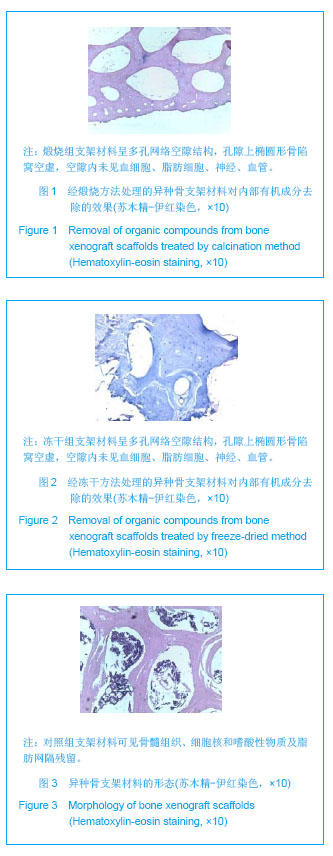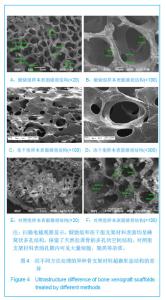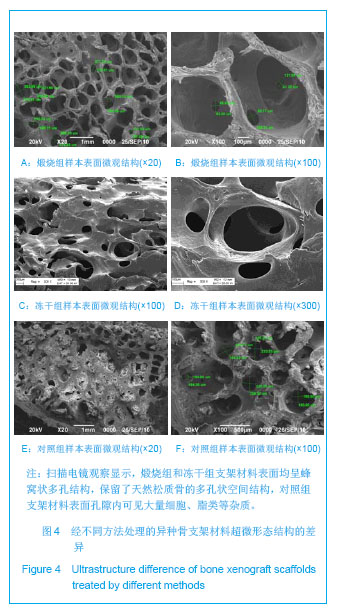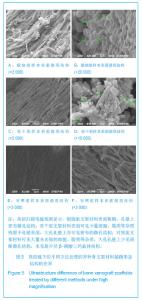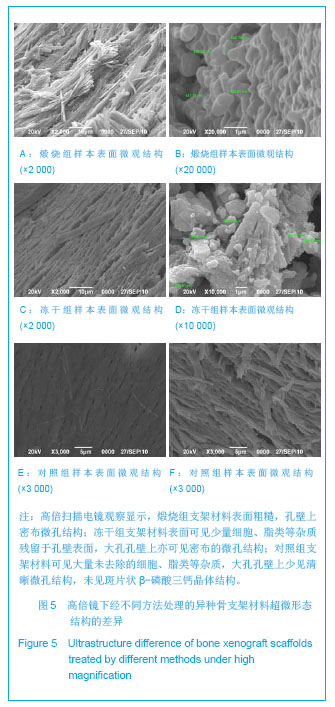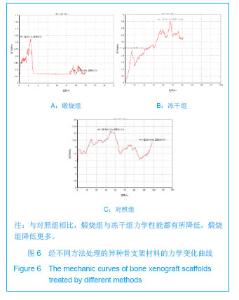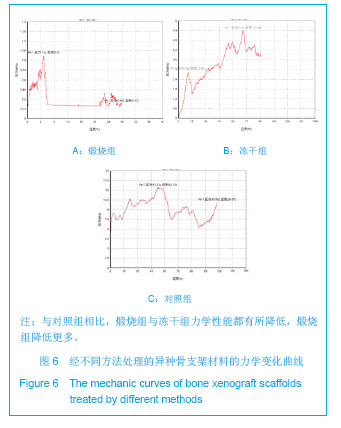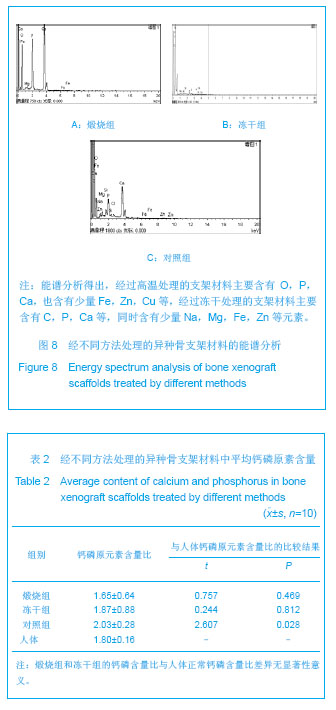Chinese Journal of Tissue Engineering Research ›› 2013, Vol. 17 ›› Issue (51): 8788-8794.doi: 10.3969/j.issn.2095-4344.2013.51.002
Previous Articles Next Articles
Xenogeneic bone properties prepared by calcination and freeze-dried methods
Yang Ze-hui1, He Hui-yu1, Cui Jie1, Wang Xiao-zhi1, Zhou Zheng2
- 1 Department of Prosthodontics, First Affiliated Hospital of Xinjiang Medical University, Urumqi 830054, Xinjiang Uygur Autonomous Region, China; 2 Department of Stomatology, First Affiliated Hospital of Shihezi University, Shihezi 832000, Xinjiang Uygur Autonomous Region, China
-
Online:2013-12-17Published:2013-12-17 -
Contact:He Hui-yu, Master’s supervisor, Professor, Department of Prosthodontics, First Affiliated Hospital of Xinjiang Medical University, Urumqi 830054, Xinjiang Uygur Autonomous Region, China hehuiyu01@126.com -
About author:Yang Ze-hui★, Studying for master’s degree, Department of Prosthodontics, First Affiliated Hospital of Xinjiang Medical University, Urumqi 830054, Xinjiang Uygur Autonomous Region, China shzuyzh@163.com -
Supported by:the National Natural Science Foundation of China, No. 81060088*
CLC Number:
Cite this article
Yang Ze-hui, He Hui-yu, Cui Jie, Wang Xiao-zhi, Zhou Zheng. Xenogeneic bone properties prepared by calcination and freeze-dried methods[J]. Chinese Journal of Tissue Engineering Research, 2013, 17(51): 8788-8794.
share this article
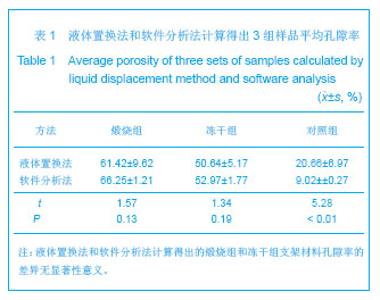
图5高倍镜观察可见,煅烧组支架材料表面粗糙,孔壁上密布微孔结构,通过与PDF数据库比对可以看到呈柱状排列的羟基磷灰石晶体,20 000倍视野下可见其晶体呈椭圆型,β-磷酸三钙斑片状晶体结构分布在羟基磷灰石晶体微孔周围,最小微孔孔径约为 0.12 μm。冻干组支架材料表面比较粗糙,可见少量细胞、脂类等杂质残留于孔壁表面,大孔孔壁上亦可见密布的微孔结构,羟基磷灰石晶体晶体呈柱状排列,未见斑片状β-磷酸三钙晶体结构。对照组支架材料可见材料表面粗糙,其上可见大量未去除的细胞、脂类等杂质,大孔孔壁上少见清晰微孔结构,羟基磷灰石晶体结构不清晰,未见斑片状β-磷酸三钙晶体结构。 2.3 经不同方法处理的异种骨支架材料孔隙率的差异 煅烧组和冻干组骨支架材料孔隙率明显大于对照组(P < 0.01),且煅烧组骨支架材料的孔隙率大于冻干组(P < 0.01),液体置换法和软件分析法计算得出的煅烧组和冻干组支架材料的孔隙率比较差异无显著性意义(P > 0.05),但对照组液体置换法和软件分析法计算得出的支架材料的孔隙率比较差异有显著性意义(P < 0.01),见表1。"
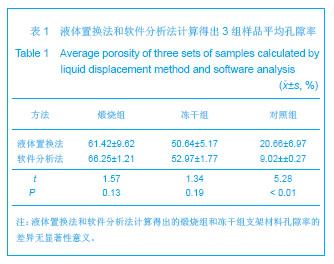
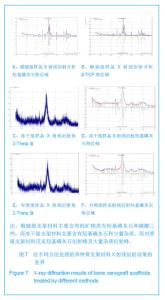
通过万能力学测试仪对3组样品的力学性能检测,煅烧组支架材料与对照组相比,根据图6中曲线的走形,煅烧组比较陡直而对照组比较缓和,说明煅烧组支架材料脆性明显增加而韧性降低,表明煅烧后对力学性能影响较大。而冻干组和对照组支架材料的力学性能没有出现明显的变化,说明冻干组力学性能优于煅烧组,高温煅烧则降低了支架材料的抗压性能。 2.5 经不同方法处理的异种骨支架材料化学性能的差异 2.5.1 X射线衍射分析结果 3组样品经过衍射分析,与数据库中标准值比对得出,煅烧组支架材料主要含有的矿物质为羟基磷灰石和磷酸三钙,而冻干组支架材料主要含有羟基磷灰石和少量杂质,而对照组支架材料仅见羟基磷灰石衍射峰及大量杂质衍射峰,见图7。"
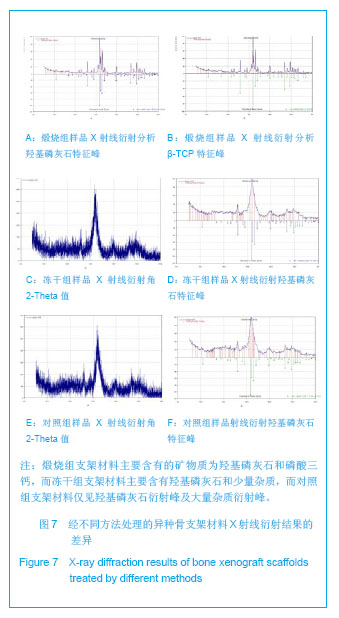
| [1]Louis-Ugbo J, Murakami H, Kim HS, et al. Evidence of osteoinduction by Grafton demineralized bone matrix in nonhuman primate spinal fusion. Spine (Phila Pa 1976). 2004;29(4):360-366; discussion Z1.[2]Athanasiou VT, Papachristou DJ, Panagopoulos A, et al. Histological comparison of autograft, allograft-DBM, xenograft, and synthetic grafts in a trabecular bone defect: an experimental study in rabbits. Med Sci Monit. 2010;16(1): BR24-31.[3]Develioglu H, Unver Saraydin S, Kartal U. The bone-healing effect of a xenograft in a rat calvarial defect model. Dent Mater J. 2009;28(4):396-400.[4]Park SA, Shin JW, Yang YI, et al. In vitro study of osteogenic differentiation of bone marrow stromal cells on heat-treated porcine trabecular bone blocks. Biomaterials. 2004;25(3): 527-535.[5]Mastrogiacomo M, Muraglia A, Komlev V, et al. Tissue engineering of bone: search for a better scaffold. Orthod Craniofac Res. 2005;8(4):277-284.[6]Erdemli O, Captug O, Bilgili H, et al. In vitro and in vivo evaluation of the effects of demineralized bone matrix or calcium sulfate addition to polycaprolactone-bioglass composites. J Mater Sci Mater Med. 2010;21(1):295-308. [7]Jähn K, Braunstein V, Furlong PI, et al. A rapid method for the generation of uniform acellular bone explants: a technical note. J Orthop Surg Res. 2010;5:32. [8]张富强.快速成型在生物医学工程的应用[M].北京:人民军医出版社,2009:142-143.[9]邢辉,陈晓明,张宏泉.骨组织工程支架材料[J].生物骨科材料与临床研究,2004,1(5):35-39.[10]Mastrogiacomo M, Muraglia A, Komlev V, et al. Tissue engineering of bone: search for a better scaffold. Orthod Craniofac Res. 2005;8(4):277-284.[11]郑磊,王前,裴国献. 骨组织工程中细胞外基质材料的选择[J].中华外科杂志,2000,38(10):745-748.[12]Simon CG Jr, Khatri CA, Wight SA, et al. Preliminary report on the biocompatibility of a moldable, resorbable, composite bone graft consisting of calcium phosphate cement and poly(lactide-co-glycolide) microspheres. J Orthop Res. 2002; 20(3):473-482.[13]许永华,施新猷,胡蕴玉,等.胶原-煅烧骨支架与成骨细胞相容性实验研究[J].中国临床解剖学杂志,2000,18(4):358-359.[14]王金成,李志洲,陈伟,等,骨库骨的生物力学特性比较研究[J].骨与关节损伤杂志,2001,16(1):35-36.[15]杨春蓉.骨组织工程支架研究现状及面临的问题[J].中国组织工程研究与临床康复,2009,13(8):1529-1532.[16]邓红文,刘耀中.骨生物学前沿[M].北京:高等教育出版社.2006: 110-131.[17]刘雷,李起鸿,唐康来,等.异种脱蛋白组织工程骨支架材料的制备及理化特性研究[J].第三军医大学学报,2007,29(1):12-14.[18]Zhao F, Yin Y, Lu WW, et al. Preparation and histological evaluation of biomimetic three-dimensional hydroxyapatite/ chitosan-gelatin network composite scaffolds. Biomaterials. 2002;23(15):3227-3234.[19]Kurashina K, Kurita H, Wu Q, et al. Ectopic osteogenesis with biphasic ceramics of hydroxyapatite and tricalcium phosphate in rabbits. Biomaterials. 2002;23(2):407-412.[20]Ramay HR, Zhang M. Biphasic calcium phosphate nanocomposite porous scaffolds for load-bearing bone tissue engineering. Biomaterials. 2004;25(21):5171-5180. |
| [1] | Zhu Ning, Yang Xinming, Ruan Jianwei. Triptolide improves spinal cord injury recovery via upregulation of autophagy and inhibition of apoptosis in Thy-yfp transgenic mice [J]. Chinese Journal of Tissue Engineering Research, 2020, 24(在线): 1-. |
| [2] | Liao Yuan, Qu Mengjian, Liu Jing, Zhong Peirui Zeng Yahua, Wang Ting, Xiao Hao, Li Lan, Liu Danni, Yang Lu, Zhou Jun. Effects of ultrashort wave on inflammatory response in rats with acute lung injury [J]. Chinese Journal of Tissue Engineering Research, 2020, 24(在线): 2-. |
| [3] | Kong Desheng, He Jingjing, Feng Baofeng, Guo Ruiyun, Asiamah Ernest Amponsah, Lü Fei, Zhang Shuhan, Zhang Xiaolin, Ma Jun, Cui Huixian. Efficacy of mesenchymal stem cells in the spinal cord injury of large animal models: a meta-analysis [J]. Chinese Journal of Tissue Engineering Research, 2020, 24(在线): 3-. |
| [4] | Li Xiaoqun, Xu Kaihang, Ji Fang. Corylin inhibits osteoclastogenesis and attenuates postmenopausal osteoporosis in mice [J]. Chinese Journal of Tissue Engineering Research, 2020, 24(在线): 4-. |
| [5] | Zhang Shuang, Xu Xiaomei, Zeng Yang, Yuan Xiaoping, Lin Fuwei. Rev-erbα’s effect on osteoblastogenesis of mouse bone marrow mesenchymal stem cells [J]. Chinese Journal of Tissue Engineering Research, 2020, 24(31): 4921-4926. |
| [6] | Xun Chong, Wang Qiang, Li Changzhou, Liu Xiaofeng. Potential molecular targets and therapeutic mechanisms underlying transplantation of autologous bone marrow stem cells for the treatment of spinal cord injury based on bioinformatics [J]. Chinese Journal of Tissue Engineering Research, 2020, 24(31): 4927-4933. |
| [7] | Chen Jia, Yang Yiqiang, Hu Chen, Chen Qi, Zhao Tian, Yong Min, Ma Dongyang, Ren Liling. Fabrication of prevascularized osteogenic differentiated cell sheet based on human bone marrow mesenchymal stem cells and human umbilical vein endothelial cells [J]. Chinese Journal of Tissue Engineering Research, 2020, 24(31): 4934-4940. |
| [8] | Liao Jian, Huang Xiaolin, Zhou Qian, Huo Hua, Qi Yuhan, Wu Chao, Shi Qianhui, Yang Tongjing, Liao Yunmao, Liang Xing. Calcined bone/chitosan composite promotes osteogenic differentiation of bone marrow mesenchymal stem cells in Sprague-Dawley rats [J]. Chinese Journal of Tissue Engineering Research, 2020, 24(31): 4941-4947. |
| [9] | Wang Guoliang, Li Yanlin, Xiang Yaoyu, Jia Di, Li Canzhang, He Lu. MicroRNA expression profiles of chondrocytes in osteoarthritis induced by stromal cell derived factor 1 [J]. Chinese Journal of Tissue Engineering Research, 2020, 24(31): 4948-4953. |
| [10] | Li Yuanqi, Lin Hai, Luo Hongrong, Zhang Xingdong. Relationship between mitochondrial autophagy and chondrogenesis of bone marrow mesenchymal stem cells [J]. Chinese Journal of Tissue Engineering Research, 2020, 24(31): 4954-4960. |
| [11] | Liu Hao, Liu Jun, Rui Yongjun, Tang Fenglin, Lu Miao, Ding Tao. Co-transfection by Nell-1 and Noggin-shRNA promotes osteoblast differentiation of adipose derived mesenchymal stem cells [J]. Chinese Journal of Tissue Engineering Research, 2020, 24(31): 4966-4970. |
| [12] | Wei Renyue, Li Xuechun, Li Yan, Yu Yang, Zhang Yu, Liu Zhonghua. A serum-free monolayer method for differentiation of porcine induced pluripotent stem cells into vascular endothelial cells [J]. Chinese Journal of Tissue Engineering Research, 2020, 24(31): 4971-4978. |
| [13] | Gu Yubo, Zhang Dongliang, Yuan Wei, , Song Lujie. Exosomes from adipose-derived stem cells can promote cavernous nerve regeneration in rats [J]. Chinese Journal of Tissue Engineering Research, 2020, 24(31): 4979-4985. |
| [14] |
Zheng Haijun, Jin Hui, Cui Hongling, Zhu Yakun, Zeng Hui, Han Fengjie, Qiu Cuiting, Liu Jing.
Safety of drug-coated balloon versus drug-eluting stents in the treatment of type 2 diabetes mellitus complicated by coronary artery small vessel disease in older adult patients [J]. Chinese Journal of Tissue Engineering Research, 2020, 24(28): 4573-4579. |
| [15] |
Ma Chao, Wang Huishan, Han Jinsong, Yin Zongtao, Zhang Xiling.
Cardiac valve prosthesis implantation and surgical maze ablation for the treatment of valvular disease with atrial fibrillation [J]. Chinese Journal of Tissue Engineering Research, 2020, 24(28): 4580-4587. |
| Viewed | ||||||
|
Full text |
|
|||||
|
Abstract |
|
|||||
